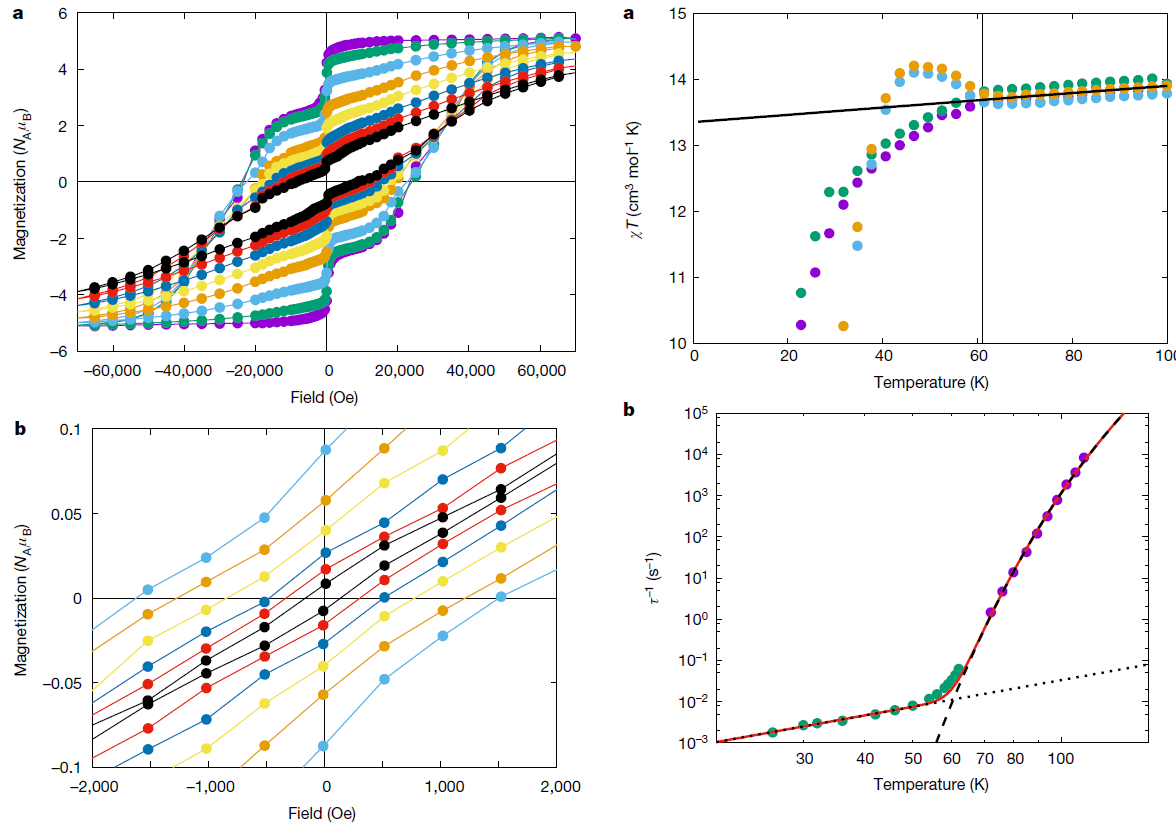 Synthesis and molecular structure of a complex of molecules [Dy (Cp ttt ) 2 ] [B (C 6 F 5 ) 4 ] with dysprosium (Dy)
Synthesis and molecular structure of a complex of molecules [Dy (Cp ttt ) 2 ] [B (C 6 F 5 ) 4 ] with dysprosium (Dy)Scientists at the University of Manchester have
developed a data storage method that makes it possible to achieve information density about 100 times higher than with the help of existing technologies. That is, about 25 terabytes of information can be stored in the device with a volume of about five rubles.
The method involves storing data in single-molecule magnets with dysprosium atoms, which in the course of the experiment exhibited
magnetic hysteresis - a memory effect, like in ferromagnets in permanent magnets and on the surface of hard disks.
Hysteresis in molecules with dysprosium atoms is manifested at the highest temperature that has been achieved so far at 60 K, i.e. −213 ° C. This is a conceptual experiment designed to demonstrate the viability of a method. Scientists suggest that the creation of commercial systems using this technology will be possible in the near future, subject to "prudent molecular design."
The potential for molecular data storage is huge. This technology makes it possible to achieve an information density of 200 terabits per square inch, which is not closely demonstrated by any of the existing technologies.
"This is very interesting, because magnetic hysteresis in individual molecules implies the ability to store binary data," says Dr. Nicholas Chilton of the
School of Chemistry at the University of Manchester. - The use of individual molecules for data storage can theoretically increase the density of data by a factor of 100 compared with existing technologies. Here we are approaching the temperature of liquid nitrogen. This means that storing data in individual molecules becomes much more viable from an economic point of view. ”
The effect of magnetic memory is a necessary requirement for any data storage system on magnetic media. Although the temperature of –213 ° C seems to be too low for practical use of technology, but in fact it is quite a working temperature. Already, liquid helium with a temperature of −269 ° C is used in data center cooling systems. A relatively high operating temperature of the new system, if it is still slightly increased, will allow the use of cheaper liquid nitrogen (−196 ° C). Actually, such a goal is set by the authors of the scientific work. They intend to raise the operating temperature of the system, ideally, above the temperature of liquid nitrogen.
Almost 25 years have passed since the discovery of single-molecule magnets, but during this time physicists have been able to increase the hysteresis temperature from 4 K to only 14 K at a magnetic field sweep rate of about 20 oersted per second. Higher temperatures were observed only at higher speeds of the magnetic field sweep (for example, 30 K at 200 O / s). So, the current opening of the hysteresis at 60 K at only 22 O / s is a very significant achievement, a real breakthrough in single-molecule magnets.
In their work, the researchers used a lanthanoid called
dysprosium , and specifically - a complex of molecules [Dy (Cp
ttt )
2 ] [B (C
6 F
5 )
4 ], where Cp
ttt = {C
5 H
2 t Bu
3 -1,2 , 4}, and
t Bu = C (CH
3 )
3 Magnetic hysteresis (left) and relaxation dynamics (right)
Magnetic hysteresis (left) and relaxation dynamics (right)Lanthanides are metals with atomic numbers from 57 to 71, that is, from lanthanum to lutetium. Today, these rare earth metals are widely used in industry, in the production of various electronic devices, such as smartphones, tablets and laptops.
Dysprosium is a chemical element with the number 66. It is not found in nature in its pure form, but is part of some minerals, for example, xenotime. It is extracted together with other lanthanides, one of the largest world deposits is located on the Kola Peninsula in Russia. Dysprosium is now used in the production of superpower magnets, as well as in nuclear power, electronics, metallurgy, medical lasers, catalysts, and also as a powerful magnetostrictive material, that is, changing its linear dimensions with remagnetization.
The material demonstrated the properties of hysteresis in such a way that scientists made two conclusions: first, these properties are unique to dysprosium, and secondly, hysteresis should be observed at higher temperatures, including higher temperatures of liquid nitrogen. This will be the subject of future research.
Increasing the information density of drives by 100 times means that storage devices will become more compact and will consume less electricity. The greatest benefit from this will get the owners of data centers. For example, there are 2.5 million servers
in Google’s 15 data centers (
as of 2016 ).
Data centers consume a huge amount of electricity. According
to reports of environmentalists, their share can be up to 2% of the total world energy consumption. Maybe this is a bit too high figures, but anyway, any energy efficient technology for data centers will benefit not only the owners of data centers, but also the entire ecology of the planet.
The scientific article was
published on August 23, 2017 in the journal
Nature (doi: 10.1038 / nature23447).